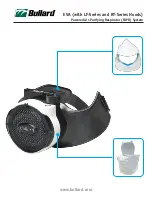
2
Oilless Reciprocating Air Compressor Pumps
4. Clearance must allow for safe, effec-
tive inspection and maintenance.
5. If necessary, use metal shims or level-
ing pads to level the compressor.
Never use wood to shim the
compressor.
VENTILATION
1. If the oilless compressor is located in
a totally enclosed room, an exhaust
fan with access to outside air must be
installed.
2. Never restrict the cooling fan exhaust
air.
3. Never locate the compressor where hot
exhaust air from other heat generating
units may be pulled into the unit.
WIRING
Refer to the general safety guidelines
manual. All electrical hook-ups must be
performed by a qualified electrician.
Installations must be in accordance
with local and national electrical codes.
Use solderless terminals to connect the
electric power source.
PIPING
Refer to the general safety guidelines
manual.
1. Make sure the piping is lined up
without being strained or twisted
when assembling the piping for the
compressor.
2. Appropriate expansion loops or
bends should be installed at the com-
pressor to avoid stresses caused by
changes in hot and cold conditions.
3. Piping supports should be anchored
separately from the compressor to
reduce noise and vibration.
4. Never use any piping smaller than
the compressor connection.
5. Use flexible hose to connect the out-
let of the compressor to the piping so
that the vibration of the compressor
does not transfer to the piping. Make
sure the flexible hose is rated for
proper pressure and temperature
before installing.
SAFETY VALVES
Tank mounted compressors are shipped
from the factory with safety valves
installed in the tank manifold. The flow
capacity of the safety valve is equal to
or greater than the capacity of the
compressor.
1. The pressure setting of the safety
valve must be no higher than the
maximum working pressure of the
tank.
2. Safety valves should be placed ahead
of any possible blockage point in the
system, i.e. shutoff valve.
3. Avoid connecting the safety valve
with any tubing or piping.
4. Manually operate the safety valve
every six months to avoid sticking or
freezing.
HOURMETER
The hourmeter on the oilless compres-
sor indicates the actual number of
hours the unit has been in operation.
The hourmeter is also used to deter-
mine maintenance and service timing.
An hourmeter must be installed
with every oilless compressor
.
CONDENSATE DRAIN VALVE
A condensate drain valve must be
installed on any tank to allow removal
of the liquid which will collect during
compressor operation.
Drain liquid from
tank daily.
Operation
Powerex oilless single stage compres-
sors operate at a maximum pressure of
125 PSIG. Two stage compressors oper-
ate at a maximum of 145 PSIG and are
equipped for continuous run operation.
Compressor RPM’s are established by
Powerex based on horsepower and
operating pressure.
NOTICE
BEFORE START UP
1. Make sure all safety warnings, labels
and instructions have been read and
understood before continuing.
2. Remove any shipping materials,
brackets, etc.
3. Confirm that the electric power
source and ground have been firmly
connected.
4. Be sure all pressure connections are
tight.
5. Check to be certain all safety relief
valves, etc., are correctly installed.
6. Check that all fuses, circuit breakers,
etc., are the proper size.
7. Make sure the inlet filter is properly
installed.
8. Confirm that the drain valve is closed.
9. Visually check the rotation of the
compressor pump. If the rotation is
incorrect, have a qualified electrician
correct the motor wiring.
START-UP AND OPERATION
1. Follow all the procedures under
“Before start-up” before attempting
operation of the compressor.
2. Switch the electric source breaker on.
3. Open the tank discharge valve com-
pletely.
4. Check that the compressor operates
without excessive vibration, unusual
noises or leaks.
5. Close the discharge valve completely.
6. Check the discharge pressure. Also
make sure the air pressure rises to the
designated pressure setting by check-
ing the discharge pressure gauge.
7. Check the operation of the pressure
switch or the pilot valve for continu-
ous run units by opening the stop
valve and confirming the compressor
starts or reloads as pressure drops.
Switch the breaker OFF if the compres-
sor is not to be used for a long period
of time.
These units are
equipped with
head unloaders for continuous run
operation.
NOTICE
Minimum Clearances
Above
24”
Drive belt side
12”
Other sides
20”





































